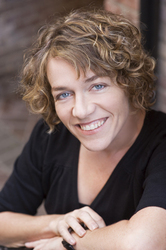Meet-the-Author Recording with Robin Stevenson
Pride: Celebrating Diversity & Community |
Robin Stevenson introduces and shares some of the backstory for creating Pride: Celebrating Diversity & Community.
Translate this transcript in the header View this transcript Dark mode on/off
Robin Stevenson: Hello, this is Robin Stevenson, and I'm the author of Pride: Celebrating Diversity and Community. I'm going to tell you a bit about how I came to write this book, and then I'll share an excerpt with you.
When I came out, twenty-five years ago, the LGBTQ community was nowhere near as visible as it is now. There has been incredible progress, both in terms of legal rights and protections, and in the hearts and minds of millions of people. But many kids still face bullying at school and fear rejection by their families. And many others are afraid to come out.
I wrote Pride for them. I wanted to tell them that even if their current reality is a hard one, they are the newest generation of a courageous, resilient, and diverse community. A community that loves them so much. I wanted them to know that they have a history they can be proud of.
I also wrote Pride for the rest of the kids, the ones who aren't part of our community, and may not even know much about it. Because it isn't just up to LGBTQ people to dismantle heterosexism and transphobia, and homophobia, it's up to everyone, and allies have always been a big part of the fight for equality.
Just like white people have a responsibility to stand up against racism, and men and boys have an important role in challenging sexism. Straight people have a part to play in the fight for LGBTQ equality, and learning more is always a good place to begin.
This book was incredibly rewarding to write. I loved talking to young people and hearing about what pride means to them. I also loved learning more about our history, because although pride day looks like a big party, it began with a riot, and it has always been about both protest and celebration.
I'm going to read you a short excerpt from the beginning of the first chapter.
To understand the beginnings of Pride, you need to understand a bit of history. The world has not always been an easy place for men who love other men, women who love other women, and people who don't conform to traditional ideas about gender. In many ways, and in many parts of the world, this is still true -- but here in North America, we really have come a long way.
Back in the 1950s, lesbians, gay men, bisexuals, and transgender people (or LGBT people for short) did not have equal rights in Canada or in the United States. It wasn't just that they couldn't get married -- same-sex relationships were actually considered a crime! LGBT people didn't have legal protection from discrimination, so they could be evicted from their homes and fired from their jobs simply for being who they were.
Restaurants and bars could refuse to serve them. They could be arrested by police for being in gay bars or nightclubs or for dancing with a same-sex partner.
But whenever there is oppression, there is resistance. People fight back -- and that is how change happens.
This Meet-the-Author Recording with Robin Stevenson was exclusively created in January 2017 by TeachingBooks with thanks to Orca Book Publishers.



